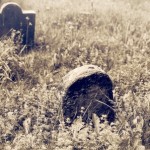Any family history researcher in New Jersey and genealogist in New York, knows that 2013’s Hurricane Sandy blew through everything, including cemeteries. What a mess! Yet, it is a familiar mess in burial grounds around the world.
Family history researchers often find that the bad weather knocks down the memorials to our family tree members. Boom! Toppled tombstones, everywhere.
Bad weather, over time, can be as damaging as a war to the world’s memorials—and memories.
Thoughts about this are timely because coming up in June, the Association for Gravestone Studies will convene their annual conference in Indiana. They talk about this kind of family history research thing and study it. So, what does the genealogy researcher do when a tombstone is down or missing?
First, let’s clarify. Sometimes a tombstone is missing because the family never put one there in the first place. At different times in economic history, families have had different levels of spending power. There have always been mass graves for those who have died in pandemics and breakouts of illness, wars and other awfulness. The poor have often been buried in Potter’s Fields with no individual markers. During the great depression, many of the nation’s families didn’t put tombstones on graves due to financial hardship. Has the same been happening with the downturn of 2008-2009?
Next, a little tombstone history here:
Early human graves were marked with piles of stones, or a cairn which is an above ground or in ground pile of stones to mark a burial site or important communal event. Native Americans in the USA had cairns. European cairns are found, also. Around the world, graves were also marked with a single large rock. Later on, as Christianity and other organized religions spread, religious symbols, such as a Celtic Cross in Ireland, marked burial sites.
Sometimes the markers were forged in wood. Most often, they were made of stone. Lots of different types of stone–sandstone, earlier, and then other types of quarried stone. As these stones crumbled, people began to use more durable rock for grave markers. The shapes and sizes of grave markers became more varied.
Originally grave markers had no words on them. Yet, as the stones became more formal in size and shape, inscriptions carved into the rock became a way for the living to mark inspirations and remembrances of the dead.
In the USA, slate was the go-to material for headstones for centuries. Then, sandstone and brownstone from east coast quarries became popular. From 1700s to early 1900s, the more durable marble and limestone were used, particularly by the wealthy. As the inscriptions faded from sandstone and limestone and marble, so did the use of those materials. By the mid-1800s, granite became the solid favorite for tombstones. To date, granite is still popular for both headstones and footstones.
So, as these (hopefully) permanent markers in our genealogy searches show wear and tear from age and weather, how does the family history researcher go about making sure your ancestor search members’ markers are well preserved?
Begin with the cemetery office staff. They will be most helpful in aiding the genealogy researcher to figure out how to right the non-upright if you, family history researcher, find a gravestone toppled or something amiss at a gravesite.
When going to a cemetery to do genealogy searches, be prepared:
- Bring pencil and paper.
- Have money for a fee or a tip.
- Bring your known family cemetery plot numbers and lots.
- Be open to finding new names buried nearby and possible additions to your family tree.
- Be ready to discuss and possibly subscribe to “perpetual care”.
- Be kind to all potential helpers (always).
Once a family history researcher finds the gravestone of interest in your ancestor search, preserve the information on the tombstone. Many a family history researcher will photograph it, take paper and rub it with graphite, study it and make notes on all the important genealogy search information. Look around to see if there are names on nearby tombstones that are similar to those in your genealogy searches. Luckily, I did that in a genealogy search in New York. I found a long lost relative’s gravestone, right near one of our known ancestor’s burial place. And, there on the found gravestone: an intact picture of our relative from 1912! That is gold for the family history researcher!
The professional genealogists at RecordClick will do ancestor searches that find gold for you. We will put the pieces together and find the graves of your relatives and more. Call us to begin, reinvigorate and complete your family history research. RecordClick goes anywhere in the world.








